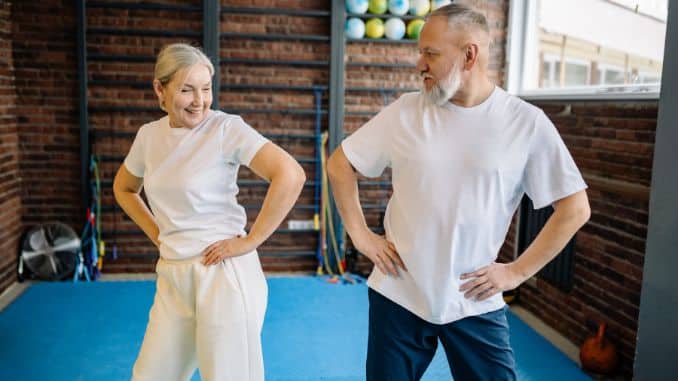You’re not alone if you’ve ever experienced that annoying popping or snapping sensation in your hip. Snapping Hip Syndrome (SHS) [1] is a common condition, and I know how frustrating it can be when that sound disrupts your movements—whether you’re walking, standing up, or even doing specific exercises. While the sound isn’t always painful, it can be bothersome enough to affect your daily routine.
But here’s the good news: You don’t have to live with it. Specific snapping hip syndrome exercises can reduce discomfort, improve mobility, and strengthen the muscles around your hip joint. I’ll walk you through a series of stretches and strengthening exercises that can help alleviate your symptoms and prevent further issues.
Here’s a preview of the snapping hip syndrome exercises I’ll be covering:
- Lateral Leg Lifts
- Kneeling Hip Flexor Stretch
- Piriformis Stretch
- Bend Over Hamstring Stretch
- Bridging
Now that you understand the importance of these exercises, let’s explore the snapping hip syndrome exercises that will help you regain control and reduce symptoms.
1. Lateral Leg Lifts
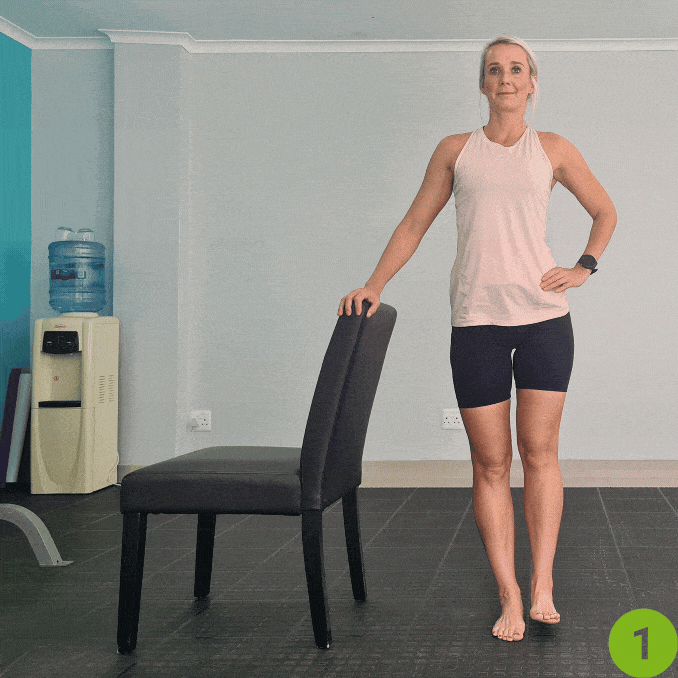
- Begin in an upright standing position beside a chair with your feet hip-width apart, maintaining good alignment with your head, shoulders, hips, and legs.
- Place one hand at the back of the chair for support while the other hand is on your hip.
- Engage your belly muscles.
- Lift one leg out to the side, ideally to a 30 to 45-degree angle.
- Keep your toes pointing forward and your leg straight.
- Lower your leg to the starting position and repeat the movement with 12–15 reps per leg to improve muscle endurance and strength with 2-3 sets.
- Relax and repeat the movement on the other leg.
2. Kneeling Hip Flexor Stretch
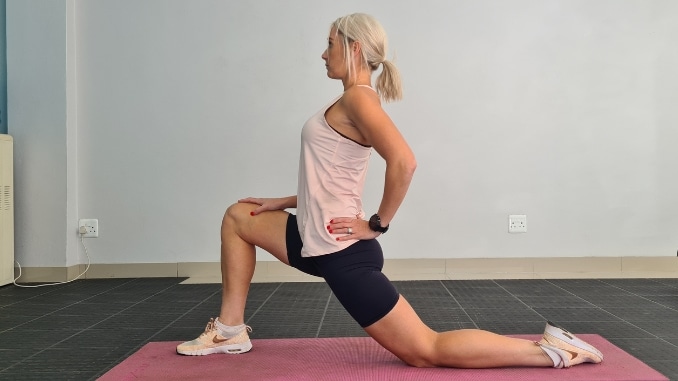
- Begin in an upright standing position, maintaining good alignment with your head, shoulders, and hips.
- Step forward and kneel with the front leg at 90 degrees, your foot flat on the floor, and your ankle, knee, and hips at a 90-degree angle.
- Engage your core and glutes, and bring your hips forward.
- Maintain a neutral spine and avoid overarching the lower back.
- Hold this position for 20-30 seconds per leg, then return to the starting position and repeat the movement on the other leg.
3. Piriformis Stretch
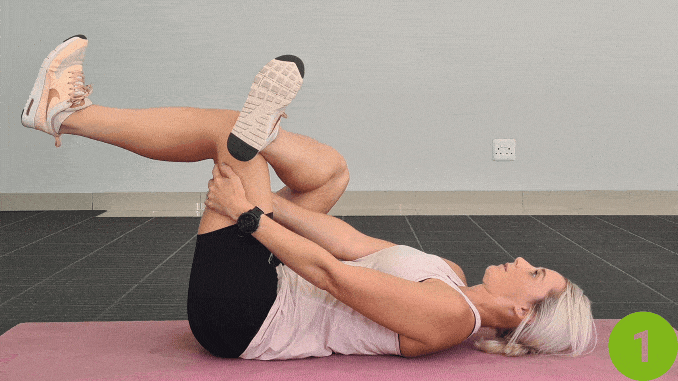
- Lie on your back on the floor with your knees bent and feet flat on the floor.
- Maintain good alignment with your head, shoulders, and hips.
- Tighten your abdominal muscles.
- Cross one leg fully over the opposite leg so your knee is crossed over your upper thigh.
- Pull the crossed knee toward your opposite shoulder, gently stretching the piriformis muscle in the affected leg.
- Hold the stretch for 30 seconds, then return to the starting position and repeat on the other side.
4. Bent Over Hamstring Stretch
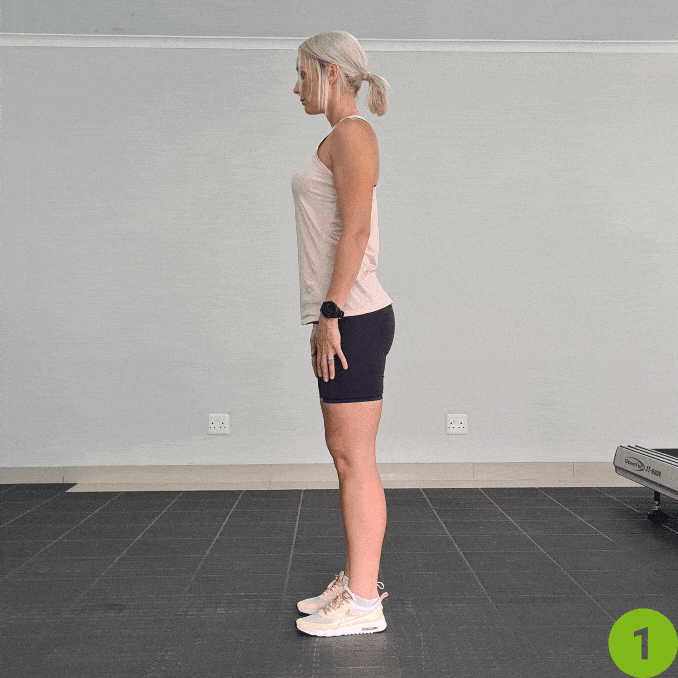
- Begin in an upright standing position with your feet hip-width apart, maintaining good alignment with your head, shoulders, hips, and legs.
- Bring one foot forward with your toes pointing toward the ceiling and engage your core.
- Hinge through your hips to bend your upper body forward, reaching for your toes with both hands while keeping your back straight.
- Keep a slight bend in the knees to avoid hyperextension and maintain a flat back throughout the movement.
- Hold the position for several deep belly breaths, in through your nose and out through your mouth.
- Relax and return to the starting position.
- Repeat the movement on the other leg.
5. Bridge
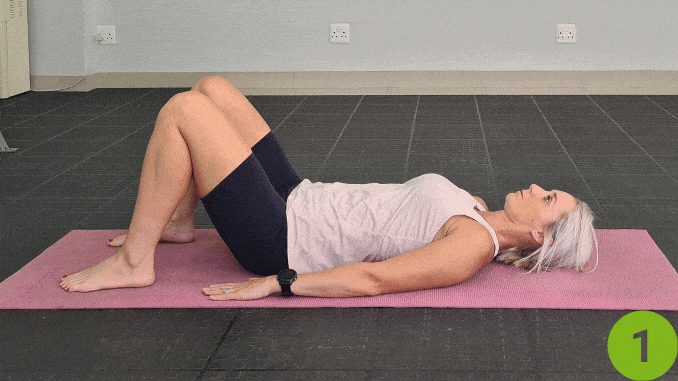
- Lie on your back on the floor with your knees bent and your feet flat, relaxing your upper body.
- Extend your arms at your sides.
- Contract your abdominal area, then push from your heels to lift your hips.
- Hold this position for a couple of deep belly breaths, in through your nose and out through your mouth.
- Relax and return to the starting position.
- Repeat the movement for 10–15 repetitions per set.
What is Snapping Hip Syndrome

Snapping Hip Syndrome occurs when a tendon or muscle in the hip moves over a bony prominence in the hip joint, creating a popping or snapping sensation. This condition can affect people of all activity levels, but it’s particularly common among athletes or those who engage in repetitive movements like running or cycling.
There are two primary types of snapping hip syndrome:
- Internal snapping hip: This occurs when tendons, such as the iliopsoas tendon, move over bony structures inside the hip, causing the snapping sensation.
- External snapping hip: This happens when the iliotibial band or other muscles move over the greater trochanter (the outer bony part of the hip), causing a snap outside the hip.
Although SHS usually doesn’t cause severe hip pain, it can lead to discomfort and, in some cases, other issues like bursitis (inflammation of the fluid-filled sacs that cushion the hip joint). SHS can also occur in less active individuals due to muscle imbalances or structural issues. Knowing what causes the snap is crucial for understanding how to treat it.
Common Causes
- Iliotibial Band (ITB) tightness: According to Dr. Michael Rowe, owner of SpineCare Decompression and Chiropractic Center, one of the main causes of Snapping Hip Syndrome is poor joint mobility, with Iliotibial Band (ITB) tightness often causing the ITB to snap over the greater trochanter, leading to that familiar pop or click.
- Tendon movement: Tendons, like the iliopsoas or rectus femoris, can cause a snapping sensation when they shift over bony prominences.
- Hip labral tear: Damaged cartilage or loose pieces of cartilage can cause the hip to catch, resulting in discomfort and clicking sensations.
When to Seek Medical Help
While SHS is often manageable with snapping hip syndrome exercises, it’s essential to seek medical advice if the condition causes persistent hip pain, difficulty moving, or affects your daily activities. A healthcare provider can offer personalized treatment recommendations, including physical therapy or, in rare cases, surgery.
Why These Snapping Hip Syndrome Exercises Work

The muscles and tendons surrounding your hip joint stabilize and allow smooth joint movement. However, when these muscles become tight or weak, they can contribute to the snapping sensation. That’s where snapping hip [2] syndrome exercises come in.
By incorporating specific stretches and strengthening exercises into your routine, you can:
- Increase flexibility: Stretching the muscles around the hip joint improves flexibility, which can reduce the snapping sensation.
- Strengthen the muscles: Strengthening the affected leg, glutes, and thigh muscles helps improve stability, reducing strain on the tendons and preventing future snapping.
- Promote mobility: Maintaining healthy movement patterns through regular stretching and strengthening helps prevent stiffness, improving overall hip flexion.
Maximizing the Benefits of Snapping Hip Syndrome Exercises
To get the most out of your snapping hip syndrome [3] exercises, it’s crucial to stay consistent. Remember to:
- Start Slowly: If you’re new to these exercises or recovering from an injured leg, begin at a comfortable pace and gradually increase the intensity as you gain strength.
- Focus on Form: Proper form is key to preventing injury and ensuring the exercises are effective.
- Stay Consistent: Practice these exercises regularly for the best results—ideally, 3-4 times per week.
- Monitor and correct: Monitor and correct asymmetries in strength or flexibility to avoid exacerbating the condition.
Preventing Snapping Hip Syndrome: Lifestyle Tips
While exercises are essential, lifestyle modifications can also help prevent Snapping Hip Syndrome from recurring:
- Improve Posture: Maintaining good posture throughout the day can reduce stress on the hips and pelvis, lowering the risk of tendon tightness.
- Stay Active: Regular physical activity helps keep muscles flexible and strong, which can prevent the snapping sensation from returning.
- Avoid Overuse: If you’re an athlete or regularly perform repetitive movements, avoid overloading the hip joint. Ensure you’re doing exercises that strengthen the muscles surrounding the affected leg.
- Warm-ups and cooling down: Proper warm-ups, cool-downs, and regular hip-strengthening exercises will help prevent injury.
Conclusion
If you’re like me, you’ve probably had enough of that bothersome painful snapping hip sensation. But the great news is that you can take control and reduce the discomfort caused by Snapping Hip Syndrome with the right exercises. Incorporating these stretches and strengthening exercises into your routine will relieve symptoms and improve hip flexion and mobility.
If you’re still experiencing discomfort or if the symptoms worsen, I recommend consulting a healthcare provider or physical therapist for personalized guidance. Don’t let Snapping Hip Syndrome slow you down—take action today.
Are you constantly troubled by joint pain, bad posture, or stress? Unlock Your Hip Flexors may be the solution you’ve been searching for! Check out now!
FAQ’s
How long does it take to get rid of snapping hip syndrome?
The recovery time depends on the severity of the condition and adherence to exercises. Minor cases may improve in a few weeks, while more severe cases could take several months with consistent effort. Typically, you may not notice a significant improvement for at least 3 weeks. However, with consistent treatment and exercises, your hip should begin to feel more normal again within about 8 weeks.
Can you play sports with snapping hip syndrome?
If the condition is persistent, formal physical therapy may be necessary. You can return to playing sports once you’re able to perform sport-specific activities without pain. Limiting or modifying exercises that trigger the symptoms, like traditional sit-ups and leg lifts, can help speed up the process.
How should I sleep with snapping hip syndrome?
To manage symptoms while sleeping, it’s important to keep your hips aligned. If you sleep on your back, place a pillow under your knees. If you’re a side sleeper, try placing a pillow between your knees to help reduce strain on your hip.
Is snapping hip syndrome a disability?
While not typically considered a disability, chronic cases can limit mobility and daily functioning. If symptoms persist, consult a healthcare provider for tailored treatment. However, any loose cartilage in the hip joint can result in the sensation of the joint locking or catching, which may require medical intervention.

